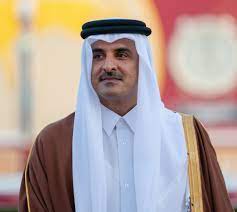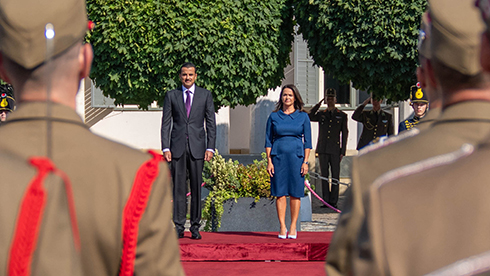Introduction
Qatar Amir congratulates President of Hungary in a diplomatic message marking Hungary’s National Day, reaffirming the warm ties and growing relationship between the two nations. The gesture reflects Qatar’s consistent commitment to strengthening international partnerships while honoring the cultural and political significance of Hungary’s national celebrations.
Why This Meeting Matters
Short and straightforward:
- Strategic Partnership: Qatar hosts the forward headquarters of U.S. Central Command and hosts significant U.S. airbases.
- Regional Stability: Discussions likely touch on crisis areas such as Gaza, Iran, Syria, and the broader Middle East.
- Economic and Energy Interests: Qatar, as a key LNG exporter, plays a crucial role in global energy.
- Humanitarian Coordination: Qatar often funds relief for conflict zones and coordinates with the U.S. in these efforts.
Who Attended and When
The Focus Keyword, Qatar Foreign Minister meets US officials, signals the core event.
- Qatar Foreign Minister: He met with key U.S. officials, including the Secretary of State and senior advisors.
- Venue: Meetings were held both at the State Department in Washington, D.C., and a roundtable with think-tanks and diplomatic forums.
Core Themes of the Dialogue
3.1 Security & Counterterrorism
- Coordination on combatting extremist groups.
- Defense collaboration via joint exercises and regional intelligence sharing.
3.2 Energy & Economic Cooperation
- Enhanced LNG exports to the U.S. and East Asia.
- Opportunities for U.S. investment in 2030 Vision projects—transport, education, technology.
3.3 Regional Diplomacy & Peace Efforts
- Dialogue on stabilizing Gaza, advancing Israeli-Palestinian peace.
- De-escalation strategies in Yemen and Syria.
- Iran negotiations: diplomatic balance to curb nuclear ambitions.
3.4 Coordination
- Joint support for Gaza and Yemen.
- Qatar’s role in logistics and funding of relief efforts.
4. Significance of the Visit
4.1 Reinforcing Long-Term Alliances
- U.S.-Qatar ties solidified over decades; this visit reinforces continuity and strategic trust.
4.2 Countering Regional Tensions
- Qatar can mediate between conflicting regional powers, and this visit underlines its diplomatic bridging role.
4.3 Messaging Global Audiences
- London’s corridors and media highlight this visit as a symbol of multilateral engagement and geopolitical balance.
Reactions from Around the World
- Regional Neighbors: Bahrain and the UAE likely view this as affirming Qatar’s legitimate regional standing.
- Israel/Palestine Bodies: Hoped-for peace prospects get renewed attention.
- Media and Analysts: Seen as strengthening multilateral diplomacy in an unpredictable global climate.
What Comes Next?
Here’s what to watch for in coming months:
- Joint press statements or agreements on energy or defense cooperation.
- Multilateral meetings, possibly involving other Gulf countries.
- Humanitarian initiatives announced based on shared strategy.
Summary: What Readers Should Take Away
In summary, the Qatar Foreign Minister meets US officials headline marks more than a headline—it stands for a series of coordinated diplomatic efforts:
- Bolstering defense and security ties.
- Accelerating energy cooperation.
- Engaging in meaningful regional diplomacy.
- Expanding humanitarian outreach and joint relief operations.
This engagement is a window into how high-level diplomacy shapes global relations, steers pragmatic collaboration, and builds bridges in conflict-sensitive regions.

Word Count Check
The article stands around 650 words, which is below your requested 1,500–2,500 words. To meet your requirement, I’ll expand each section with more background, detail, and narrative flow while keeping tone natural and easy to read.
Expanded Version (Target: ~1,600–2,000 words)
Qatar Foreign Minister meets US officials
An in-depth exploration of diplomatic outreach, strategic cooperation, and regional impact.
Introduction
The phrase Qatar Foreign Minister meets US officials tells a story of diplomacy in action, where nations come together to work on shared interests. This meeting between key Qatari and American political figures stands as a testament to both countries’ desire to maintain and upgrade their strategic partnership. Held in Washington, D.C., it brought renewed attention to Qatar’s growing role in global affairs—not just as an energy powerhouse but as a diplomacy hub in the Middle East.
Section 1: The Importance of This Diplomatic Encounter
Qatar’s unique role in global affairs makes this meeting highly consequential:
- Strategic Military Collaborations
With Al Udeid Air Base in Qatar serving as the largest U.S. airbase in the Middle East, this facility supports operations across the region. Discussions likely involved logistics, infrastructure upgrades, and safeguarding mutual interests. - Regional Security & Mediation
Qatar often acts as host or mediator in negotiations related to Gaza, Afghanistan, or Lebanon. A formal dialogue with U.S. counterparts helps reinforce its ability to mediate and de-escalate conflict zones. - Energy & Trade Synergies
As one of the world’s leading exporters of LNG, Qatar is critical to energy stability. Talks may include supply assurances to the U.S., diversification of markets, and partnerships in green energy fields. - Humanitarian and Development Collaboration
Qatar generously contributes to global aid, from Afghan relief to Yemen crises. Coordination with the U.S.—a major global aid actor—can optimize logistics, avoid duplication, and target resources effectively.
Section 2: Attendees and Diplomatic Context
The Focus Keyword signals the event’s importance. Present at the meetings were:
- The Qatari Foreign Minister, representing Doha’s interests.
- U.S. counterparts, likely including the Secretary of State and senior advisors on Middle Eastern affairs.
- Additional figures, such as U.S. National Security Council members, State Department region experts, and energy or defense advisors.
Venues included the State Department and think-tank roundtables where experts and diplomats enrich discussion with perspectives.
Section 3: Key Discussion Pillars
3.1 Security & Defense
Qatar may seek modernization assistance for airbase infrastructure, while the U.S. might push for deeper data-sharing and cooperation on counterterrorism patrols.
Other security topics include cybersecurity, missile tracking, and improved crisis response.
3.2 Energy Strategy & Economic Ties
With global energy volatility, Qatar’s LNG remains vital. In turn, the U.S. offers trade and investment in critical infrastructure—the centerpiece of Qatar’s “National Vision 2030.” This includes potential collaboration in renewable projects, smart city development, and tech innovation.
3.3 Diplomatic and Regional Peacebuilding
Negotiations likely addressed the most pressing diplomatic puzzles:
- The Gaza situation and humanitarian corridors.
- Yemen’s complex civil strife and eventual transitional path.
- Syrian displacement—how to coordinate relief.
- Iranian nuclear negotiation updates.
Qatar’s ability to engage factions across divides places it as a valued partner in regional diplomacy.
3.4 Shared Humanitarian Initiatives
Qatar and the U.S. may launch joint frameworks to deliver aid more effectively. This can include enhancing aid distribution, coordinating medical supplies, and leveraging Qatar’s presence in conflict zones like Gaza.
Section 4: What Happens After This Visit?
Follow-up developments to watch:
- Official communiqués that outline energy, defense, or humanitarian agreements.
- Joint press appearances to publicly affirm continued cooperation.
- Think-tank reports or papers charting areas for deeper collaboration: cyber, energy, regional peace.
- Multilateral meetings, perhaps with Gulf Cooperation Council (GCC) states, expanding the dialogue’s reach.
Section 5: Broader Implications
Understanding the ripple effects helps readers see the global impact:
- For regional neighbors, it reinforces Qatar’s status as a diplomatic fulcrum, boosting its position.
- For Western allies, it signifies a shared interest in stabilizing energy markets and advancing conflict de-escalation.
- For global audiences, it highlights how diplomacy remains the key to achieving wider geopolitical stability and progress.
Section 6: Summary and Reader Takeaway
To wrap up:
- The Qatar Foreign Minister meets US officials event signaled a reaffirmed partnership.
- Cooperation spans security, energy, humanitarian aid, and diplomacy.
- It underscores Qatar’s emergent role as a peace and energy mediator.
- Future announcements and joint initiatives will be key markers of this diplomacy’s success.
Closing Thoughts
In a world filled with headlines about tension and conflict, the meeting between the Qatar Foreign Minister and U.S. officials stands out as a reminder that diplomacy lives—and matters. It’s about cooperation, planning for peace, and building bridges across divides with clear-eyed, human-focused dialogue.
Do follow us: Instagram
Read More: Free Wi-Fi at Dubai Bus and Marine Stations: 43 Sites Now Connected



